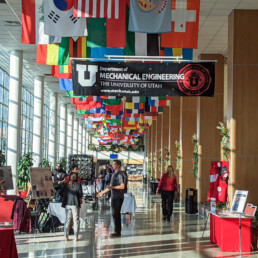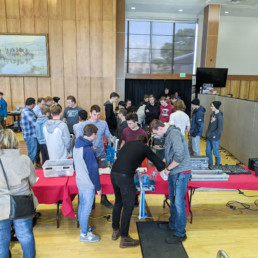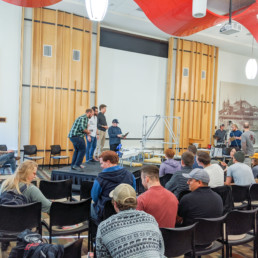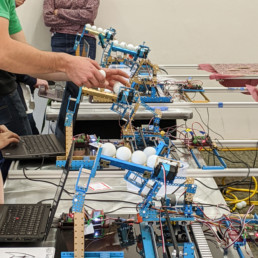Design Day - Spring 2015
Design Day is an opportunity to share our Senior Design Showcase with the public. Seniors work in groups with faculty to design and test projects.
Additionally, freshman and junior mechatronics’ students compete and showcase their skills.
Senior Design Projects
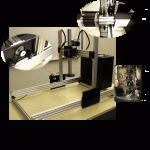 Thin film deposition is the process of applying successive thin layers of various coatings to a substrate. The purpose of thin film deposition is to attain desired chemical, mechanical, or conductive properties in the film. Prof. Scarpulla’s group has developed a strategy for deposition of CdTe used in thin film photovoltaics from successive dipping in solutions. Since this process will require hundreds of cycles of dipping in multiple solutions to build up the desired thickness of a few microns, this process must be automated. The current process uses successive dipping by hand which is tedious and irreproducible. Thus the Scarpulla lab is in need of a small scale, adaptable, automated film deposition machine. Dr Scarpulla has specifically required that the machine be compatible for at least 4 film deposition dipping baths, allow his lab researchers to input the recipe into a LabVIEW human machine interface, start a run sequence and have no other interaction required until the process is complete, have minimal cost, be compatible with his existing lab equipment, and show repeated accuracy for at least three processes.(Automated Dip Coating Deposition Poster)
Thin film deposition is the process of applying successive thin layers of various coatings to a substrate. The purpose of thin film deposition is to attain desired chemical, mechanical, or conductive properties in the film. Prof. Scarpulla’s group has developed a strategy for deposition of CdTe used in thin film photovoltaics from successive dipping in solutions. Since this process will require hundreds of cycles of dipping in multiple solutions to build up the desired thickness of a few microns, this process must be automated. The current process uses successive dipping by hand which is tedious and irreproducible. Thus the Scarpulla lab is in need of a small scale, adaptable, automated film deposition machine. Dr Scarpulla has specifically required that the machine be compatible for at least 4 film deposition dipping baths, allow his lab researchers to input the recipe into a LabVIEW human machine interface, start a run sequence and have no other interaction required until the process is complete, have minimal cost, be compatible with his existing lab equipment, and show repeated accuracy for at least three processes.(Automated Dip Coating Deposition Poster)
Team: Adam Terry (lead), Matthew Adamson, CJ Eldredge, Shane Shoemaker
Advisor: Dr. Mike Scarpulla
Atmospheric scientists, ski resorts, departments of transportation and even hobbyists desire superior snow measurement systems to those currently available. Current inexpensive options do not produce adequate measurement accuracy, while more costly options (upwards of $2500) maintain high accuracy, but still lack verification of observation quality and some measurement options. The primary function of the proposed snow measurement system is to take a photo of the snowfall and measure snow depth, air temperature, wind speed, relative humidity and potentially wind direction and solar radiation. The objective of the Automated Snow Measurement System Team is to design, build and test a device for the University of Utah Atmospheric Science Department that will collect all required meteorological data at a cost significantly lower than current market prices. (Automated Snow Measurement System Poster)
Team: Peter Vander Wilt (lead), Caroline Biggs, Scott Blackhurst, Kyle Dewey, Virgina Gould
Advisors: Drs. Eric Pardyjak and Jim Steenburgh
Quadcopters are dangerous and difficult to use. Some quadcopters attempt to solve this problem through the use of GPS flight guidance systems, but this approach is only viable in wide open outdoor environments. The Autopilot Quadcopter Team has developed a solution which will allow any operator to safely and easily fly a quadcopter in indoor environments. The solution combines a sensor-based collision avoidance system with a custom quadcopter frame to reduce the frequency and severity of collisions, improving the user’s experience. (Autonomous Collision Avoidance Aerial Robot Poster)
Team: Brad Barber (lead), Michael Bills, Joey Bourne, Lucas Constenius
Advisor: Dr. Kam Leang
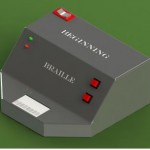 There is a lack in available technologies to assist people trying to learn braille. According to NBC news, 56% of people with impaired vision who can read braille are employed while only 23% of people with impaired vision that cannot read braille are employed [1]. Currently there are few devices on the market that do not require supervision and help from a person with sight to facilitate learning. There are some devices that contain audio input, audio output, and a refreshable braille screen, but there is no device currently on the market that incorporates all of these. The proposed project is a beginning braille training device to enable a person with impaired vision to learn how to read braille on their own. The device will provide audio feedback, sensory feedback through a refreshable screen that displays braille characters, and basic learning modules to teach an individual how to feel and interpret braille characters. The braille training device will not require a teacher or supervision to facilitate learning. The device will also be designed to be hand held and portable. (Beginning Braille Training Device Poster)
There is a lack in available technologies to assist people trying to learn braille. According to NBC news, 56% of people with impaired vision who can read braille are employed while only 23% of people with impaired vision that cannot read braille are employed [1]. Currently there are few devices on the market that do not require supervision and help from a person with sight to facilitate learning. There are some devices that contain audio input, audio output, and a refreshable braille screen, but there is no device currently on the market that incorporates all of these. The proposed project is a beginning braille training device to enable a person with impaired vision to learn how to read braille on their own. The device will provide audio feedback, sensory feedback through a refreshable screen that displays braille characters, and basic learning modules to teach an individual how to feel and interpret braille characters. The braille training device will not require a teacher or supervision to facilitate learning. The device will also be designed to be hand held and portable. (Beginning Braille Training Device Poster)
Team: Beau Freckleton (lead), Jason Castillo, Adam Daly, Austin Eastman, Kelton Gubler, Andrew Silotti
Advisor: Dr. Andrew Merryweather
 The Bio-Sensing Chip is an early-warning system designed to detect diseases in the initial stages. The device is a proof of concept project that might eventually be implanted into the human body to alert the patient to seek medical attention before the disease fully develops. It detects disease by identifying biomarkers that become present in the bloodstream as a result of a disease. Biomarkers are biological responses to disease, infection, and other phenomena. The quantity of biomarkers in a person’s body relate to the advancement of the disease. Additionally, the Bio-Sensing Chip can detect biomarkers by chemically attaching them to microspheres. The quantity of these microspheres can be measured and correlated to the stage of a disease. The user of the device can then be alerted to the presence of the disease and seek further medical care. (Bio-Sensing Chip Poster)
The Bio-Sensing Chip is an early-warning system designed to detect diseases in the initial stages. The device is a proof of concept project that might eventually be implanted into the human body to alert the patient to seek medical attention before the disease fully develops. It detects disease by identifying biomarkers that become present in the bloodstream as a result of a disease. Biomarkers are biological responses to disease, infection, and other phenomena. The quantity of biomarkers in a person’s body relate to the advancement of the disease. Additionally, the Bio-Sensing Chip can detect biomarkers by chemically attaching them to microspheres. The quantity of these microspheres can be measured and correlated to the stage of a disease. The user of the device can then be alerted to the presence of the disease and seek further medical care. (Bio-Sensing Chip Poster)
Team: Rachel Ware (lead), Sarah Bentley, Jaron Peck, Parker Vance
Advisor: Dr. Bruce Gale
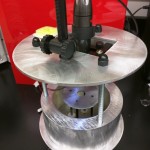 Atomic force microscopes (AFMs) are a relatively new technology. Instead of using lenses like conventional microscopes, they touch the surface and use a laser and photodiode to produce and image. This technology is very expensive with most AFMs costing hundreds of thousands of dollars. If AFMs could be built for less money, more laboratories and schools could adopt this technology. Our team set out to design and build an AFM for under $5000. (Budget Atomic Force Microscope Poster)
Atomic force microscopes (AFMs) are a relatively new technology. Instead of using lenses like conventional microscopes, they touch the surface and use a laser and photodiode to produce and image. This technology is very expensive with most AFMs costing hundreds of thousands of dollars. If AFMs could be built for less money, more laboratories and schools could adopt this technology. Our team set out to design and build an AFM for under $5000. (Budget Atomic Force Microscope Poster)
Team: Daniel Bejarano (lead), Joshua Bello, Kyle Kersey, Parker Okabe, Jiajie Xu
Advisor: Dr. Keunhan Park
Construct a device that will assist researchers in predicting how thermal energy spreads within the body to improve heat treatments for cancer therapies. The device needs to provide accurate, reliable data by reproducing the cooling effects of blood flow. The intent of the device is that it will serve as a stepping stone in order to facilitate future research in modifying current bio-heat/conduction equations to apply to all situations in the human body. The device will contain substituted blood vessels and tissue. (Cancer Therapy Poster)
Team: Ryan Brewster (lead), William Gibson, Taejun Hur, Greg Newman, Alberto Puga, Taylor Swan
Advisor: Dr. Robert Roemer
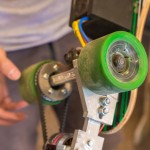 The C. U. T. Board promotes a green alternative to urban transportation. This is accomplished by integrating a wirelessly controlled motor to a longboard providing safe acceleration and braking. To add convenience in transportation and storage, a collapsing mechanism has also been implemented, which folds the board in half while maintaining structural integrity. (CUT Board Poster)
The C. U. T. Board promotes a green alternative to urban transportation. This is accomplished by integrating a wirelessly controlled motor to a longboard providing safe acceleration and braking. To add convenience in transportation and storage, a collapsing mechanism has also been implemented, which folds the board in half while maintaining structural integrity. (CUT Board Poster)
Team: Jared Pieper (lead), Joshua Corey, Daniel Pett, Don Phan
Advisor: Dr. Larry DeVries
The Composite Motorcycle Frame Team designed and built a carbon fiber motorcycle frame specifically for commuter use. The driving force behind this project was that current commuter motorcycles are overbuilt for their intended use. The use of carbon fiber allows for a lighter more maneuverable frame. (Composite Motorcycle Frame)
Team: North Parker (lead), Dave Brimley, Jose Ramirez
Advisors: Drs. Dan Adams and Larry DeVries
TerraTek, a division of Schlumberger, provides rock mechanics and core analysis services for oil and gas well development companies. One of the tests provided is an ultrasound wave velocity test. This test is able to determine properties of the rock such as density, porosity and strength. The current methods for acquiring ultrasound wave velocities involve taking plugs out of the rock core and capturing single location velocities. The productivity and consistency of a well can be better predicted if velocity measurements are taken over the whole core sample rather than just at the locations of these small plugs. The Continuous Velocity Measuring System for Rock Core Team is tasked with developing a system that has the capacity to move along the length of the core while measuring the ultrasound velocities. While there are currently velocity measuring systems available on the market today they do not have the ability to collect data along the length of rock cores, which are typically over 3 feet long, and require a liquid material to be applied to the surface of the sample. It is desired by TerraTek that a test set up be developed that can attach onto a pre-existing fixture and collect the sound wave velocity along the length of an entire rock core without the use of a liquid coupling material. (Continuous Velocity Measuring System for Rock Core Poster)
Team: Patrick Adamson (lead), Richard Didier, Jonathan Hardy, Steven Paulus, Kristy Thayne
Advisor: Dr. James Guilkey
We designed and manufactured a customizable multi-tool. This multi-tool is called the EDC Pro and it is centered around the user being able to interchange and repurpose their tool to their immediate needs. (EDC Pro Poster)
Team: Thomas Tyler (lead), Arlen Chung, Robert Torick, Jeff Wiest
Advisor: Dr. Larry DeVries
The project is exploring the power output and efficiency of a Stirling engine in order to understand if harvesting low-temperature waste heat from power plants is a feasible solution. The project involves testing the mechanical power output of a Stirling engine at a 20-30°C temperature difference. Also, building and analyzing a electromagnetic generator and circuitry to deliver usable power is involved in the project. (Electricity Harvesting from Low-temperature Waste Heat Poster)
Team: Roger Backman (lead), David Alveno, Kyle Armstrong, Christian Bauer, Viginia Diaz, Brandon Link
Advisor: Drs. Kuan Chen and Shad Roundy
The Formula SAE Monocoque Team is creating a carbon fiber sandwich composite front monocoque for this year’s University of Utah Formula car. The monocoque will be the whole front end of the racecar, housing the driver, steering, pedals etc. and acting as a support for the front suspension, wheels, and rear sub-frame of the car. Along with designing the monocoque, the team will also be designing other areas of the car such as steering, braking, and seating. Once finished, the Utes Formula Car will be taken to Michigan in May to compete against 120 schools from around the world in an international competition consisting of different race events that will challenge every aspect of the car’s design. (Formula SAE Monocoque Team Poster)
Team: Eric Green (lead), Peter Creveling, Todd Critchlow, Nick Crocker, Ben O’Harra
Advisor: Dr. Samuel Drake
The Formula Society of Automotive Engineers (FSAE) competition challenges teams of university undergraduate and graduate students to conceive, design, fabricate, develop and compete with small, formula style, vehicles. This competition requires students to design unique racecars to perform in several events. The FSAE Engine Team is tasked with repairing and developing a normally aspirated KTM 525 engine to use to turbo charger and fuel injector, with the goal of obtaining a functional and optimally performing engine before the competition in May 2015. Additional tasks include ensuring engine and its peripherals are packaged efficiently and compliant with 2015 FSAE Rules. The primary goal of this project is to provide an engine that allows the 2015 FSAE Team to qualify and compete in the 2015 FSAE competition. (Formula SAE Racecar Engine Poster)
Team: Brian Phung (lead), Thomas Carpenter, Cyrus Jordan, Jim Hoffmeister
Advisor: Dr. Samuel Drake
This project challenged the Suspension team to design and optimize the vehicle suspension and dynamics of the race car by using the modeling and analysis techniques that were studied in the ME courses, and use computer simulations to model the travel range, maximize the strength properties, and minimize the weight of the system. The Suspension team will provide analysis of all test results and calculations performed that determined the final design of the system. the Formula U Racing Team, with all 3 teams combined, will present a fully assembled car that has been tested and refined to perform as desired. (Formula SAE Suspension Team Poster)
Team: Scott Kyle (lead), Shaun Edwards, Michael Nguyen, Brennen Wong
Advisor: Dr. Samuel Drake
The main objective of the wheelchair transfer system project is to find a safe, simple way to transfer someone with limited lower-body mobility from a wheelchair to a bed, toilet, car, or shower chair. The wheelchair transfer system project focused on improvements to the current design of transfer boards. Transfer boards are utilized to transfer someone by placing one side of the board on the person’s wheelchair and the other side of the board on the surface to be transferred to. The person then slides across the board, either with assistance or without, to the other surface. The wheelchair transfer system project improved upon the current designs by implementing a smooth gliding track and break system, and safety features, such as a combination backrest handrail, track encasing and seat stops. (Gliding Wheelchair Transfer System Poster)
Team: Marsha Barker (lead), Stephanie Hunter, Nathan McDonald, Kelbie Ockey, Matthew Pell, Michael Pell
We are building a three wheeled recumbent bicycle that will be able to tilt like a two wheeled bicycle. The picture attached shows the back end of the human powered vehicle. The front will extend another 2-1/2 feet from the end of the frame being held up in the picture. (Human Powered Vehicle Poster)
Team: jarom Taylor (lead), Sam Diebal, Karl Espell, Derrel Peterson, Will Wu
Advisor: Dr. Sanford Meek
The purpose of this project is to build a hydro-electric generator with no infrastructure such as dams or reservoirs. The generator is self-contained within a single structure and will utilize a paddle wheel type design to provide electrical power using an already existing, running water source. (Low-infrastructure Hydroelectric Generator Poster)
Team: Clay Audd (lead), Dustin DeLaHunt, Alex Olson, Yang Peng
Advisor: Dr. Meredith Metzger
In the medical industry, one of the most commonly used items is an Intravenous Line (IV). It is used in the administration of medications and other fluids. When medical professionals prepare an IV line for use, purging all air from the assembly is extremely important. Air not removed can travel from the IV line into the patient’s bloodstream resulting in an air embolism. This project aims to reduce or eliminate air accumulation, eliminate residual medication within the port, have transparency of the port, and adhere to ISO standard 294-1 for port connection. (Needleless IV Port Redesign Poster)
Team: Paul Jeppson (lead), Omar Flores, Sharoon Samuel, Andrew Young
Advisor: Dr. Meredith Metzger
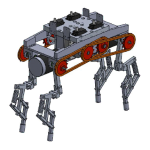 Trotting is defined as the synchronized movement of alternating diagonal pairs of legs in four-legged animals. The main goal was to engineer a control system that enabled the quadruped to perform its intended function, which is to trot. The necessary sensors and component modifications were designed, and the hardware was installed. The electrical components were configured and connected such that the necessary inputs and feedback from the robot would be possible. A complex Simulink model was designed to command all of the necessary motions of the robot using feedback from the installed sensors. In addition, a testing platform that protects the robot and uses an actively controlled treadmill to aid in testing was designed and manufactured. There were many challenges along the way, but overall the project was successful. (Quadruped Robot Poster)
Trotting is defined as the synchronized movement of alternating diagonal pairs of legs in four-legged animals. The main goal was to engineer a control system that enabled the quadruped to perform its intended function, which is to trot. The necessary sensors and component modifications were designed, and the hardware was installed. The electrical components were configured and connected such that the necessary inputs and feedback from the robot would be possible. A complex Simulink model was designed to command all of the necessary motions of the robot using feedback from the installed sensors. In addition, a testing platform that protects the robot and uses an actively controlled treadmill to aid in testing was designed and manufactured. There were many challenges along the way, but overall the project was successful. (Quadruped Robot Poster)
Team: Carly Beardall (lead), Matt Johnson, Bryson Murray, Zach Walker, Eddie Yazzie
Advisor: Dr. Sanford Meek
Water is a critical commodity that makes life possible in remote locations such as ranches, homesteads and cabins. Currently, if a property owner wants to utilize their water source for irrigation or plumbing, the use of some sort of common pump which requires an external power source such as electricity or fuel is typically needed. If power is not readily available or reliable this can leave people stranded without water and other necessities. Our project addresses these problems and provides a sustainable advantage by utilizing a ram pump. A ram pump is a completely mechanical device that is comprised of a series of chambers and check valves. These valves and chambers allow the pump to utilize the energy of flowing water to create a higher pressure water supply. This allows water to be moved to higher elevations, or a substantial distance from the water source. This water can be captured in a cistern, livestock watering tanks or even a small water tower for use in plumbing and irrigation. (Ram Pump Design Poster)
Team: Sam Despres (lead), Austin Brown, Richard Elder, Jeff Schade, Ben Stoddard
Advisor: Dr. Meredith Metzger
MECHANICAL DRIVES VS. ELECTRICAL DRIVE: The initial design of mechanical drive system used a pneumatic vane motor to drive the rock crusher. In order to meet the design requirements of 3 hp at 180 rpm the vane motor would require a 10:1 gearbox reducer and a 40 hp single stage air compressor to provide the necessary flow of compressed air. Due to the high cost, low efficiency, and large required floor space of the pneumatic system, it was decided that a hydraulic system would better meet the design requirements. (Reliable Controls Rock Crusher Drive System Poster)
Team: Andrew Blanco (lead), Bryan Cerda, David Fetherstone, Thomas Taylor
Advisor: Dr. Marc Bodson
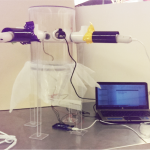 The sensory response of various insects is an important topic of study in entomology. One of the most important applications of insect sensory response is in agriculture. Certain insects are beneficial because they are the sole source of pollination to some plants. Conversely, pest insects destroy much of the world’s food supply each year, both during crop growth and storage. Understanding which specific chemical, light, humidity, and temperature levels attract and repel particular insects can attract useful insects and minimize consumption by pests.
The sensory response of various insects is an important topic of study in entomology. One of the most important applications of insect sensory response is in agriculture. Certain insects are beneficial because they are the sole source of pollination to some plants. Conversely, pest insects destroy much of the world’s food supply each year, both during crop growth and storage. Understanding which specific chemical, light, humidity, and temperature levels attract and repel particular insects can attract useful insects and minimize consumption by pests.
The current systems used to examine insect behavior have limitations in accuracy and the types of stimuli that can be tested. The goal of this team is to develop a device to evaluate insect preferences to various temperature, light, and color levels. It will benefit researchers by providing a more realistic testing environment and automatically recording outcomes. Gaining a better understanding on how to attract or repel certain insects can assist the agricultural industry and help save the world’s food supply. (Save the World’s Food Supply Poster)
Team: Michelle Watrous (lead), Joshua Chidester, Jiawei Yan, Muhammad Zakri
Advisor: Dr. Robert Roemer
This project is to improve upon the design of the current Paylock SmartBoot. Paylock’s SmartBoot is designed so that the recipient of the parking boot can pay their fine over the phone and receive an unlock code to take the boot off themselves by punching the code into a keypad on the boot. This eliminates the need for officers to go back to the location and remove the boot themselves. However Paylock’s current boot has a very high theft rate (20% in Oakland) and costs $450 to manufacture. Our task is to make the SmartBoot more secure and also cheaper to make. (Self-release Parking Boot Poster)
Team: Kevin Han (lead), Robert Buckner, Justin Johnson, Collin Ynchausti, Shuai Zhang
Advisor: Dr. Shad Roundy
In a car accident, passive safety devices, such as airbags and seat belts, are used to mitigate injuries and death. At the instant when an automobile accident occurs, airbags deploy when the crash sensor sends a signal to the airbag initiator. The initiator ignites small pyrotechnic material which generates the release of a safe, nitrogen based gas resulting in deployment of the airbag. At the Autoliv Ogden Technical Center, they R&D department continually tests new developments in passive safety devices, including airbags. At the Technical Center, the pyrotechnic materials are loaded into the initiators, called a micro gas generator (MGG), by a manual process. This process is inconsistent, inaccurate, and has a varying cycle time to fill each MGG. To assist Autoliv in the process, a system will be designed and built to improve accuracy, precision, and the cycle time to fill the MGGs for airbag prototypes. (Semi-automated Pyrotechnic Loading Machine for Filling Micro Gas Generators in Air Bag Systems Poster)
Team: Cody Wayment (lead)(ME), David Elwell (ME), Jacqueline Gonzalez (EE), Kevin Hao (EE), Justin Wettstein (ME)
Advisor: Dr. Kam Leang
Teahupoo Turbines is designing and fabricating and Surface Extractable Marine Current Turbine to harness marine current and tidal energy in the world’s oceans. The system will be capable of being submerged and surfaced using a buoyancy-based extraction system that can be controlled by an operator at the water surface to eliminate the need to hire professional divers and remotely operated vehicles for maintenance of the system. (Surface Extractable Marine Current Turbine Poster)
Team: Doug Beard (lead), Robert Hilliard, Keaton Rich
Advisor: Dr. Meredith Metzger
Time lapse is a popular method of videography that is composed of many photos taken over a long period of time. In the past, these time lapse videos were captured with the camera in a stationary position. Present videographers commonly add linear and panning motion to produce more intriguing shots. These devices do exist, however, each device is proprietary to the type of camera rail that is used. This project focuses on providing a device that is universally compatible with all rail systems, that is capable of linear and panning motion, that is affordable to the amateur, and produces quality videos. (Universal Time Lapse Poster)
Team: Eric Davis (lead), Kevin Kusuda, Jonathan Tayler, Boston Walbeck
Advisor: Dr. Larry DeVries
A photonic or plasmonic crystal-enhanced luminescence measurement tool is to be designed that has angular mapping capabilities over an emission spectral range of 420-620 nm. By using a charge-coupled device (CCD) camera with an integrated variable filter wheel, measurements will be taken to categorize luminescence emitted from the sample spectra. An Energetiq broadband laser-driven light source (LDLS) will be used in conjunction with an excitation filter and polarizer in order to create narrow-band excitation of a phosphorous-coated sample mounted on a rotation stage. The resulting spectra will then be passed through a long-pass or bandpass emission filter, terminating on a screen placed in front of a fixed CCD camera imaging the entire screen. Because non-Lambertian angular distribution is expected in some designs, the sample will be rotated and measurements of the emission spectra will be taken at various angles to allow for two-dimensional angular mapping. (Variable Angle Luminescence Mapping Poster)
Team: Tyler Green (lead), Sam Judd, Andrew Unsworth, Thomas Weatherwax
Advisor: Dr. Steve Blair
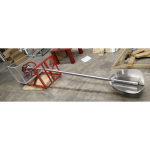 The 2015 Wave Energy team has been focused on improving upon the previous years design and testing the machine. The 2015 team is the third team to work on the Wave Energy machine with the previous two teams being unable to test the machines ability under water. This year the ultimate goal has been to submerge the entire machine within a wave tank and test the ability of the machine to harness the subsurface elliptical motion of waves and convert this motion into usable electricity. (Wave Energy Poster)
The 2015 Wave Energy team has been focused on improving upon the previous years design and testing the machine. The 2015 team is the third team to work on the Wave Energy machine with the previous two teams being unable to test the machines ability under water. This year the ultimate goal has been to submerge the entire machine within a wave tank and test the ability of the machine to harness the subsurface elliptical motion of waves and convert this motion into usable electricity. (Wave Energy Poster)
Team: Sean Troyner (lead), Jordan Johnson, Cory Pymm, Brian Willhard
Advisor: Dr. Meredith Metzger
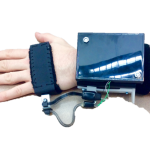 The objective of our project is to create an enjoyable experience for patients undergoing physical therapy on their lower arm. Creating an enjoyable experience will increase patient compliance and promote a fuller recovery. Our device will promote a fuller recovery by wirelessly converting performed ROM(range of motion) exercises into a game. The game will be an android app that will read in the different wrist deflections and relate them to movements in the game. (Wreach Poster)
The objective of our project is to create an enjoyable experience for patients undergoing physical therapy on their lower arm. Creating an enjoyable experience will increase patient compliance and promote a fuller recovery. Our device will promote a fuller recovery by wirelessly converting performed ROM(range of motion) exercises into a game. The game will be an android app that will read in the different wrist deflections and relate them to movements in the game. (Wreach Poster)
Team: Zakary Wilde (lead), Mike Hansen, J. Thomas Jenkins, Brian Moore, Cody Steele
Advisor: Dr. Robert Roemer
Junior Mechatronics Competition 2015
Robot Volleyball
Mechatronics students are collaborating to build teams of tele-operated robots to compete in a robot volley ball tournament. Each lab section is designing, manufacturing, and programming three unique robots and controller interfaces that the use to drive the robots during gameplay. Robots must be compact and able to serve and return the ball. Teams earn bonus points for volleying the ball before returning it to the opposing team.
Freshmen Competition 2015
Battleship
Sixty four teams have been assembled in the Pacific Ocean to demonstrate their programming skills and compete for elite status. Each team will control an identical “ping-pong” missile launcher, which must be programmed to hit six randomly located battleships. Teams must first use MATLAB programming to correctly identify the coordinates of the battleships in a provided satellite image and transmit them to the microcontrollers on-board their launchers. Their launchers must be programmed to autonomously aim, shoot, and reload. Points will be awarded for identifying and hitting each battleship, with time acting as a tie-breaker.
